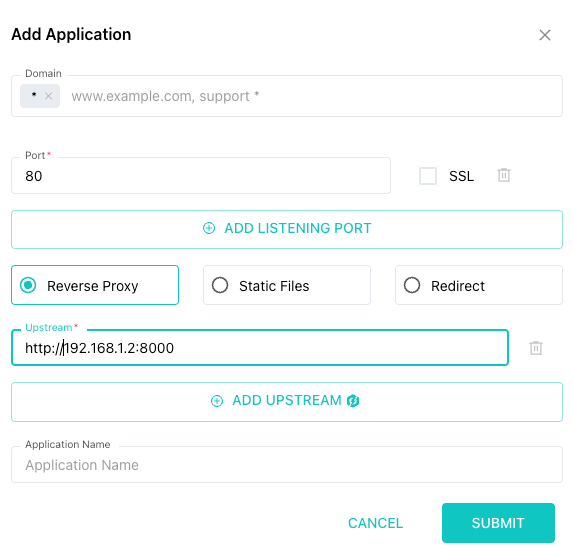SafeLine WAF supports three site configuration modes, each designed for different web deployment scenarios:
- Proxy to an existing website
- Static file hosting
- Redirect to another site
Let’s walk through each mode and how to set them up.
1. Proxy to an Existing Website
This mode is ideal when you already have a working website, and you want to protect it with SafeLine.
Example Scenario:
You have a website running at 192.168.1.2:8000, and the domain is demo.safeline.com. You want SafeLine to sit in front and provide security protection.
Key Configuration Fields
-
Domain:
This is the domain visitors will use to access your site via SafeLine. Default is
*(no restriction), but it’s recommended to specify something likedemo.safeline.comto limit access.
💡 Remember to update your domain's DNS records to point to the WAF server’s IP address, otherwise traffic won’t pass through SafeLine.
Port:
The listening port on SafeLine. Use80for HTTP or443for HTTPS (check the SSL option if using HTTPS).Upstream Server:
The original backend web server you want to protect. In our example, set this tohttp://192.168.1.2:8000.
💡 If you encounter an error like
nginx: [emerg] duplicate listen options for 0.0.0.0:80,
it means the port is already in use. Check if another process like Nginx is occupying the port and resolve the conflict.
- Note: Optional. You can enter a memorable name for the site.
2. Static File Hosting
If you’re hosting a static frontend website (HTML/CSS/JS) and want WAF protection, this is the right mode. No upstream server is needed.
Steps:
- Specify the listening port and domain as needed.
- After the site is created, switch to the Static Resources tab to upload your files.
- You can upload individual files or a
.zippackage. SafeLine will automatically extract and overwrite the content directory.
3. Redirect to Another Site
This mode is used when you want to redirect traffic from an old domain to a new one.
Example:
Redirect old.safeline.com to new.safeline.com with a 301 permanent redirect.
Test Your Setup
Once configured, access your domain and check if it routes correctly.
Try simulating an attack like an SQL injection and see if it gets blocked. If it does—your WAF is working!
Troubleshooting
How to check if traffic is going through SafeLine?
All traffic passing through SafeLine will include a cookie named sl-session in the response headers. Check for this to confirm.
Port Conflict?
Use tools like lsof or ss to find which process is using the port. Resolve the conflict by stopping or reconfiguring the offending service.
Tengine Keeps Restarting?
If the tengine container keeps restarting, possible causes include:
- Port conflict
- Invalid DNS settings
- Corrupted or invalid configuration
Check logs for errors, or run the reset script to restore defaults:
cd /data/safeline && bash reset_tengine.sh
Final Thoughts
SafeLine offers flexible site deployment modes that work for both traditional and modern web setups. Whether you're proxying, serving static files, or redirecting old domains, the configuration process is simple and intuitive.
Start protecting your site in just a few minutes.






Top comments (2)
Great post! I like how clearly you explained the three deployment modes (Proxy, Static, Redirect) with practical examples. The troubleshooting tips (like lsof, ss, and reset_tengine.sh) are super helpful.
To make it even better, consider adding a note on HTTPS setup, caching for performance, and maybe a simple diagram to illustrate each mode. Overall, a clear and useful guide for SafeLine beginners—well done!
Some comments may only be visible to logged-in visitors. Sign in to view all comments.